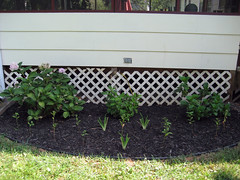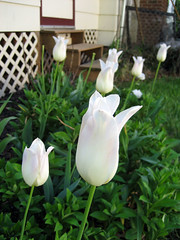Gooseneck Loosestrife - Attack!
If we are ever invaded by a foreign army, I have no worries. My gooseneck loosestrife can easily fend them off and keep our home safe.
I transplanted 12 modest twigs of loosestrife from my MIL's garden in Fall 2007. One of the twigs was mowed down by a bunny, and another mysteriously disappeared in the night.

I was amazed by how much the plants had filled in the following Spring.

This Spring, I am a little fearful for my yard, as not only has the loosestrife multiplied again, but they are breaking out of their containment area in what looks like an attempt to dominate the neighborhood. I should warn the neighbors. I have little doubt that they could take the cul de sac with minimal effort.

My intention was for these plants to fill in this area with a thick lush blanket, and I am overjoyed to see my plan come to fruition in such a short period. If you enjoy the delicate curving heads of gooseneck loosestrife, but fear for your yard's safety, simply cut the bottom out of a large plastic pot, plunge the pot into the ground and plant the loosestrife in that containment area. It will probably keep the plants from spreading ... mostly. Loosestrife is certainly not deterred by poor soil either, so plant it anywhere!

I have noticed some people landing on my blog in search of a way to remove gooseneck loosestrife. My suggestion is to dig it up. You would need to completely cultivate the entire area down to 18" to ensure you get all the roots. You won't get them all, but this will be a good start. As you see little baby heads poking back up, plunge your spade deep into the ground around it and extract that bad boy and his roots. I suggest this method over using Round Up although chemicals would be much easier. Please only use chemicals as a last resort. They make the earth cry.
In other news, these pink tulips that are interplanted with the loosestrife turned white this year!

I suspected that the reason is due to the hybrid bulbs reverting back to their parental form, and my horticulturist / landscape architect / master gardener friend Hillary confirmed that to be true. Pretty cool stuff.
Labels: asheville, gardening, gooseneck, loosestrife

0 Comments:
Post a Comment
Subscribe to Post Comments [Atom]
<< Home